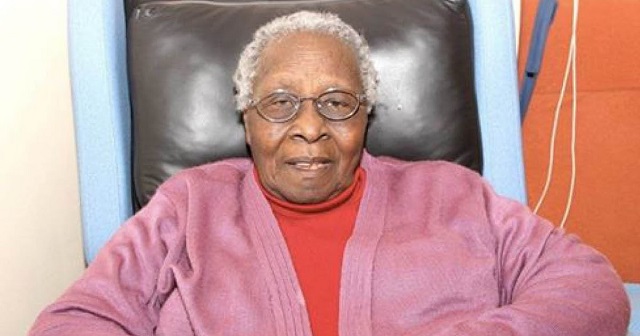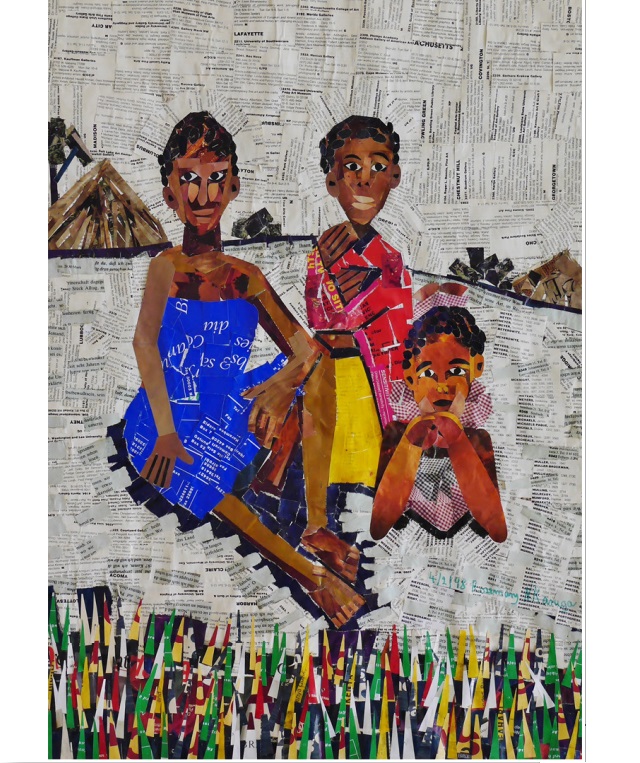
She embarked on an active art career after clocking more than a century old but became one to reckon with, with paper collages that combine extraordinary detail and charming simplicity.
| DOMINIC MUWANGUZI | A typical story of a female student of fine art in the early years of Makerere Art School, was that immediately after graduating from the art school, she would resign herself to marriage as a full time job because she could not get a job as an artist. This was the fate of Rose Mary Karuga for 60 years attending to her family in a small house on the outskirts of Nairobi. She had earlier began teaching art, immediately after leaving Makerere and returning to Kenya; juggling the teaching profession with her marital roles. So for more than half a century, Mrs. Karuga went into oblivion with her cherished C.V as the first woman to graduate from the prestigious East African Art School: Margaret Trowel School of Fine Art. And at that, she had ‘compromised’ her talent in painting, design and sculpture- disciplines she had majored in, for a complete family life altogether.
The artist was born in 1928 in Meru, Kenya, and was recognized as a potential art student by the Catholic missionary nuns at a local art school. In 1950, they recommended her to join Makerere, where for two years, under the tutorage of Gregory Maloba, a fellow Kenyan, among others, she excelled in the discipline. Karuga’s studio deftness was visible in her paper collages that came to life with village and wildlife sceneries, reminiscent of the rural setting in Meru where she grew up as a little girl. The collages were often composed of paper wraps of domestic utilities like bathing soap (Rexona), Brooke Bond tea bags and Jimbi flour bags. Later, the artist acquired a more expansive texture with old glossy fashion magazines from London, Newyork and Germany. She would painstakingly paste these recycled material onto hard surface with paper glue and the result was artworks that captured elements of art including depth, perspective and immense texture- the collage paintings were layered with colour: ultra-marine blue, sky blue and deep blue, extra. The paintings also had an aspect of incongruity like observed by artist, curator and art writer Mbuthia Maina. This incompatibility in her work was suggested by the fact that she was working with different material of different textures often leaving behind traits of almost imperfections. Here, a blank spot could emerge in the composition and Karuga was compelled to cover it out of necessity with anything like a dab of acrylics or paper.
 As such, Karuga was an innovator in her own right; crossing boundaries of art making like showcased in the execution of ideas on canvas. More so, the technique of working with the available resources reflect the transitioning from pre-colonial and post-colonial era where materials for making art where everything and everywhere to the present times where objects lose value fast and are easily discarded as valueless. Previously, the artist had worked with pastels, oils and water colour but when they became unaffordable for her, she resorted to working with paper. The link between the past and future, undoubtedly suggesting resilience, is carried forward in her personality where albeit the frailty of health because of age, she continued to make art. It is a rare occurrence, for an artist in their prime to submit to an art residency. Karuga was artist in residence for three months at Paa ya Paa art gallery, Nairobi. She also kept on working at her modest home surrounded by children’s chuckling. In Ireland where she permanently relocated with her daughter, she kept working albeit her ill-health.
As such, Karuga was an innovator in her own right; crossing boundaries of art making like showcased in the execution of ideas on canvas. More so, the technique of working with the available resources reflect the transitioning from pre-colonial and post-colonial era where materials for making art where everything and everywhere to the present times where objects lose value fast and are easily discarded as valueless. Previously, the artist had worked with pastels, oils and water colour but when they became unaffordable for her, she resorted to working with paper. The link between the past and future, undoubtedly suggesting resilience, is carried forward in her personality where albeit the frailty of health because of age, she continued to make art. It is a rare occurrence, for an artist in their prime to submit to an art residency. Karuga was artist in residence for three months at Paa ya Paa art gallery, Nairobi. She also kept on working at her modest home surrounded by children’s chuckling. In Ireland where she permanently relocated with her daughter, she kept working albeit her ill-health.
In Karuga’s artistic journey, artists in the region are presented with a lesson not to limit themselves but go forward to break new grounds with their art. By participating in the seminal exhibition, Contemporary African Artists- Changing Tradition at Studio Museum, Harlem 1990, alongside Africa’s greats like El Anastsui, Aboard Glover and Tapfuma, she got exposed to an international audience. This feat-she was the only female artist who exhibited in this exhibit- re-energized her and gave her a new purpose. Hence, Karuga will always be remembered as the artist who crossed boundaries- both cultural and social- with her art.
****
Rose Mary Karuga passed on 10th February in Ireland. Additional reporting sourced from ContemporaryAnd. Images courtesy of the Web.
 The Independent Uganda: You get the Truth we Pay the Price
The Independent Uganda: You get the Truth we Pay the Price


